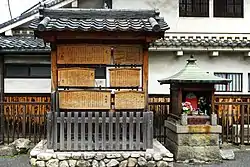Kōsatsu
A kōsatsu (Japanese: 高札, literally "High plaque"), also called Seisatu (Japanese: 制札, literally "Controlling plaque"), was a public notice of the han-lord's or shogun's proclamations earlier in Japanese history.[1] They were local or nationwide laws written on a wooden plate, placed in the kōsatsu-ba of the shukuba or sekisho (関所), the border between han, where there was frequent traffic.

Several kōsatsu were placed at the kōsatsu-ba in Gose-chō (御所町), Nara Prefecture, Japan
The kōsatsu was used from the late Nara Period until the early Meiji period. One of the kosatsu in the Edo Period was on prohibiting Christianity.[2]
As the people's literacy rate improved and the modern nation emerged, the kōsatsu was abolished in 1873 and eventually replaced by the Kanpō (Japanese government gazette) and other means of public notice.
See also
External links
Wikimedia Commons has media related to Kōsatsu.
This article is issued from Wikipedia. The text is licensed under Creative Commons - Attribution - Sharealike. Additional terms may apply for the media files.